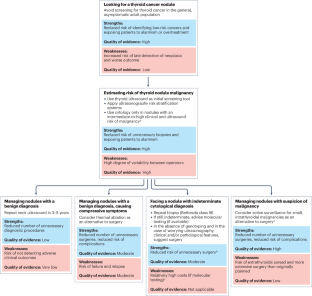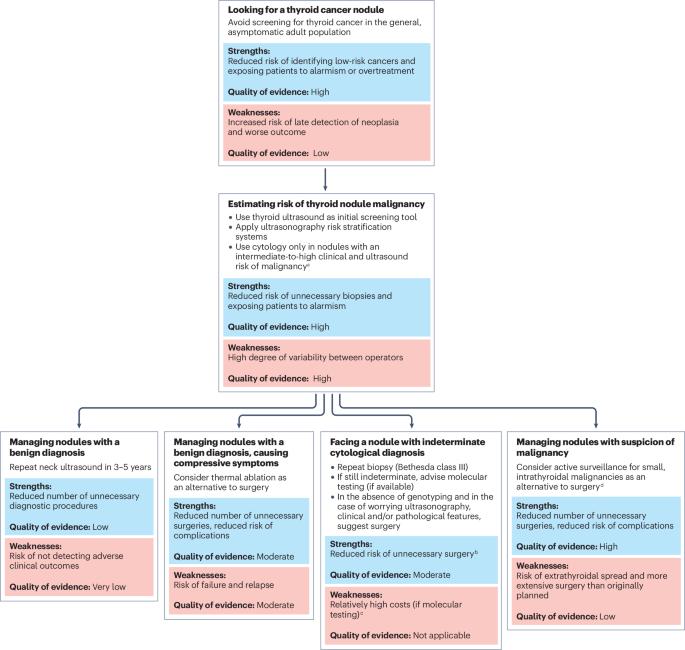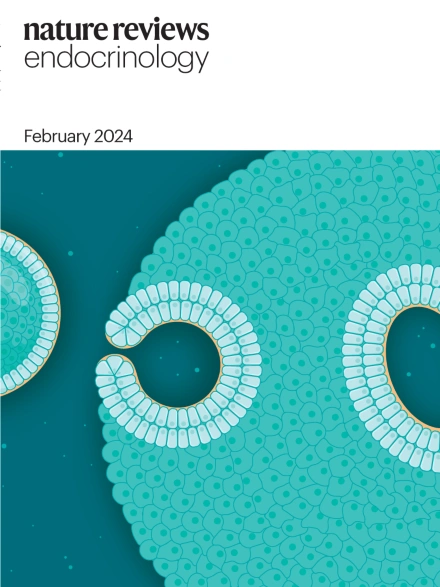Thyroid nodules: diagnosis and management
IF 31
1区 医学
Q1 ENDOCRINOLOGY & METABOLISM
引用次数: 0
Abstract
Thyroid nodules, with a prevalence of almost 25% in the general population, are a common occurrence. Their prevalence varies considerably depending on demographics such as age and sex as well as the presence of risk factors. This article provides a comprehensive overview of the prevalence, risk stratification and current management strategies for thyroid nodules, with a particular focus on changes in diagnostic and therapeutic protocols that have occurred over the past 10 years. Several sonography-based stratification systems (such as Thyroid Imaging Reporting and Data Systems (TIRADS)) might help to predict the malignancy risk of nodules, potentially eliminating the need for biopsy in many instances. However, large or suspicious nodules necessitate cytological evaluation following fine-needle aspiration biopsy for accurate classification. In the case of cytology yielding indeterminate results, additional tools, such as molecular testing, can assist in guiding the management plan. Surgery is no longer the only treatment for symptomatic or malignant nodules: active surveillance or local ablative treatments might be beneficial for appropriately selected patients. To enhance clinician–patient interactions and discussions about diagnostic options, shared decision-making tools have been developed. A personalized, risk-based protocol promotes high-quality care while minimizing costs and unnecessary testing. Thyroid nodules are common; the majority are benign and asymptomatic, and therefore the main aim of the diagnostic process is to determine their clinical significance without leading to overdiagnosis and, consequently, overtreatment, as outlined in this article.


甲状腺结节:诊断和管理
甲状腺结节在普通人群中的发病率接近 25%,是一种常见病。甲状腺结节的发病率因年龄、性别等人口统计学因素以及是否存在风险因素而有很大差异。本文全面概述了甲状腺结节的发病率、风险分层和当前的管理策略,尤其关注过去十年中诊断和治疗方案的变化。一些基于声像图的分层系统(如甲状腺成像报告和数据系统(TIRADS))可能有助于预测结节的恶性风险,在很多情况下可能无需进行活检。不过,大结节或可疑结节需要在细针穿刺活检后进行细胞学评估,以准确分类。如果细胞学检查结果不确定,分子检测等其他工具可以帮助指导治疗方案。手术不再是治疗无症状结节或恶性结节的唯一方法:积极监测或局部消融治疗可能对经过适当选择的患者有益。为了加强临床医生与患者之间的互动以及对诊断方案的讨论,我们开发了共同决策工具。基于风险的个性化方案可促进高质量的治疗,同时最大限度地降低成本和减少不必要的检查。
本文章由计算机程序翻译,如有差异,请以英文原文为准。
求助全文
约1分钟内获得全文
求助全文
来源期刊

Nature Reviews Endocrinology
医学-内分泌学与代谢
CiteScore
42.00
自引率
0.70%
发文量
158
审稿时长
6-12 weeks
期刊介绍:
Nature Reviews Endocrinology aspires to be the foremost platform for reviews and commentaries catering to the scientific communities it serves. The journal aims to publish articles characterized by authority, accessibility, and clarity, enhanced with easily understandable figures, tables, and other visual aids. The goal is to offer an unparalleled service to authors, referees, and readers, striving to maximize the usefulness and impact of each article. Nature Reviews Endocrinology publishes Research Highlights, Comments, News & Views, Reviews, Consensus Statements, and Perspectives relevant to researchers and clinicians in the fields of endocrinology and metabolism. Its broad scope ensures that the work it publishes reaches the widest possible audience.
 求助内容:
求助内容: 应助结果提醒方式:
应助结果提醒方式:


